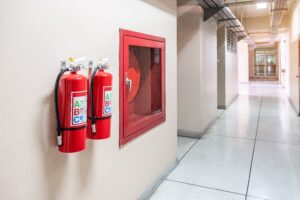
10 Tips for Fire Safety in Schools
This guide covers our Top 10 Tips for Fire Safety in Schools to ensure you haven’t missed off any of the really important, but easily overlooked facets of fire safety
Book your FREE, no-strings-attached Fire Safety Audit to ensure that you’re properly protected from the risk and comply with current fire safety legislation.
Get essential insights and updates
in fire safety – straight to your inbox!

There are around sixty fires every day involving vacant buildings, and these are only reported when someone happens to notice it. Whether you have a vacant building or one that’s left empty overnight, a monitored fire alarm could make the difference between a damaged building and a gutted one.
Whereas the most basic type of fire alarm merely alerts people within a building, fire alarm monitoring ensures that the appropriate people are alerted even if the premises are empty. If the alarm is either activated or goes into fault, a signal will be sent to an ARC (Alarm Receiving Centre). The ARC will then alert the keyholders, the emergency services or both, depending on the instructions are established on set-up.
You may have come across the same thing being called Redcare, which is actually just one brand of Fire Alarm Monitoring, owned by BT. Since at one time this had a monopoly in the market, the name is still sometimes used generically.
The crucial thing for fire alarm monitoring is that it must have two signaling paths to conform to insurance requirements. Traditionally the monitoring uses an analogue line for the primary path, and the mobile phone network as its secondary path.
One of the major things that have changed since that time is that you no longer need an analogue phone line for fire alarm monitoring. If you have a system that’s over ten years old, that’s probably how it will work, and this could be a problem, as BT is phasing out analogue telephone lines. This means that although the system will continue to work on its secondary path, it will no longer be dual path.
Fortunately, the technology has been moving over to alternative systems. Most systems now use the mobile phone network as its primary signaling path, and IP-based monitoring on the LAN network is usually the secondary path.
Another thing that you need to take into consideration is the phase out of the 3G signaling which is scheduled for the end of 2023. Some of the devices are configured to work on 2G, 3G and 4G, but not all. Speak to your fire alarm company to make sure.
Unlike an Autodialler, which simply sends a pre-recorded message to a pre-programmed number, a fire alarm monitoring system can notify multiple numbers, including the emergency services. Even if one of the “signalling paths” fails, the system will continue working on the remaining path, as well as notifying you.
Your system can be configured to monitor your intruder alarm from the same panel as your fire alarm, since the device has multiple pins and can send different signals to the ARC, identifying which system has activated. This simply involves running a cable between the devices. In general, it’s better to connect the intruder alarm to the fire alarm monitoring, rather than vice versa, otherwise you may have to increase the number of times an hour the signal is tested.
The basic fire alarm monitoring system will only tell the ARC there’s been an activation. If you want to know precisely which device has activated, we can install a Nimbus system, as long as your panel is addressable. This only works with a LAN network and will allow you to log into the control panel and see exactly what the problem is.
Our fire alarm monitoring system will work with any reasonably modern fire alarm panel, and usually takes two to three hours to install. Depending on the size of the panel, we can sometimes install the device inside it. If this isn’t possible, we’ll install an enclosure beside the panel. However, the device is powered by the panel, so no additional power supply is required.
Ideally, there should be a LAN point close to the panel, but if not we can install a WiFi connector. Similarly, if you’re relying on the mobile phone network, but the signal is poor in your area, you’ll need a data point installed beside the panel.
Saving your premises from serious fire damage is valuable enough, but our fire alarm monitoring system is also insurance approved, so you’ll see extra benefits in your insurance policy. Get in touch with us to find out more about what fire alarm monitoring could do for you.

This guide covers our Top 10 Tips for Fire Safety in Schools to ensure you haven’t missed off any of the really important, but easily overlooked facets of fire safety

Fires are often unpredictable, destructive, and can cause massive loss of life. Understanding how fire works can help us prevent it, predict it, and control it. One of the most

Keep your festive season merry and bright with essential Christmas Fire Safety tips from Blazequel. From illuminating your home safely with holiday lights to ensuring your Christmas tree doesn’t become
Video Smoke Detection is perfect for a fast response to fires in high roofed buildings and harsh operating conditions.
Watch Smokecatcher detect smoke in an MSW storage building. The smoke is coming through from a fire in the adjoining storage area.
Watch Smokecatcher detect a fire in an SRF Storage bunker. Sadly, the alarm wasn’t responded to and the site lost a 4hr window of opportunity between smoke detection and flames appearing.
Video Smoke Detection overcomes the risks of stratification and other challenges for early fire detection in logistics and storage facilities.
Watch Fire Rover detect and suppress a fire in the waste bunker at an EFW facility!
See how the Fire Rover detects and suppresses this fire at a clients tipping hall. Note how the smok is spreading out at low leve, rather than rising. This is called ‘stratification’ and is one of the many reasons why roof-mounted smoke detection systems like beam detectors and HSSD is not suitable for many recycling applications.
Watch the Fire Rover detect and suppress a fire at a battery storage facility. This targeted and intellegent control makes the Fire Rover particularly well suited to high hazard storage applications.
Watch the Fire Rover tackle a battery fire in a tipping hall. Note how the exploding battery cells start three separate fires, which the operator individually suppresses (whilst avoiding the site operators in the vicinity).
Get essential insights and updates in fire safety – straight to your inbox!
